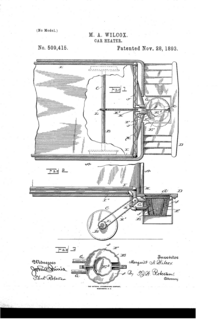Margaret A. Wilcox (1838 – March 30, 1912) was an American mechanical engineer and inventor best recognized for her late-nineteenth-century discoveries. The automotive heating system, her most famous invention, established the foundation for modern vehicle temperature control. She also contributed to the development of home appliance technology.
Margaret A. Wilcox | |
|---|---|
| Born | 1838 Chicago, Illinois, US |
| Died | March 30, 1912 Los Angeles, California, US |
| Occupation(s) | Inventor, mechanical engineer |
| Known for | The invention of the car heater, 1893. |

Early life edit
Margaret Wilcox was born in 1838 in Chicago, Illinois. Little is known about her early life, which was common for many women of her era, whose personal histories were often overshadowed by their male counterparts.[1] Wilcox showed an early interest in mechanical engineering despite the social conventions of her era, which often restricted women's roles to domestic domains.
Career and inventions edit
Throughout her career, Wilcox showed a creative spirit and adeptness at navigating the traditionally male-dominated field of mechanical engineering. During her lifetime, she made the most notable contribution to transportation comfort when she invented the car heater.[2]
By using the heat produced by cars' internal combustion engines, this device directed warm air into the passenger compartment. Although her invention, which was patented in 1893, was innovative in that it made use of the engine's residual heat, it was originally designed without a temperature control system, which resulted in overheating.[3] She also developed several stoves and housing appliances, including a combined cooking and hot water heating stove designed to save fuel by efficiently utilizing the wasted heat of the stove[4]. These inventions, although not commercially successful, demonstrated her innovative approach to solving everyday problems and her forward-thinking in appliance design.
Challenges and recognition edit
Wilcox faced many of the same difficulties that other female inventors of her era had during her career. Women filing patents under their own names was still uncommon and frequently challenging in the late 19th century. Despite these challenges, Wilcox persisted and was able to patent her creations, which is evidence of her drive and aptitude as an engineer and inventor.
Her contributions—the car heating system in particular—have subsequently been acknowledged as key innovations in the automotive sector.
Legacy and modern impact edit
Wilcox's car heating technology was the forerunner of modern in-vehicle climate control systems, which are now ubiquitous in cars, trucks, trains, and airplanes.[5] Over the years, she made various improvements to her original design, including temperature regulation elements in the ensuing decades. Her efforts are now seen as crucial to the development of vehicle comfort, improving not only passenger convenience but also the worldwide supply chain by being essential in the transfer of commodities that are sensitive to temperature.[citation needed]
Wilcox's work was produced during a period when women's contributions to science and technology were frequently disregarded or undervalued. Her perseverance and inventiveness opened the door for a new wave of female engineers and inventors.
Honors edit
In 2020, Inventor's Digest named Wilcox's patent for the car heater one of their top ten patents by women.[6]
References edit
- ^ "Women of Interest---Margaret Wilcox". The Voice. 2021-04-30. Retrieved 2023-12-06.
- ^ McGaw, Judith A. (1997). "Inventors and Other Great Women: Toward a Feminist History of Technological Luminaries". Technology and Culture. 38 (1): 214–231. doi:10.2307/3106789. ISSN 0040-165X. JSTOR 3106789. S2CID 112618007.
- ^ Williamson, Lori (January 2001). "Inventing the 19th Century: 100 Inventions that Shaped the Victorian Age, from Aspirin to the Zeppelin". History: Reviews of New Books. 30 (1): 17. doi:10.1080/03612759.2001.10525935. ISSN 0361-2759. S2CID 142757304.
- ^ Stanley, Autumn (1993). Mothers and Daughters of Invention: Notes for a Revised History of Technology. New Jersey: Rutgers University Press (published October 1, 1995). p. 55. ISBN 9780813521978.
- ^ Pilato, Denise E. (2016-12-01). "Illumination or Illusion: Women Inventors at the 1893 World's Columbian Fair". Journal of the Illinois State Historical Society. 109 (4): 374–399. doi:10.5406/jillistathistsoc.109.4.0374. ISSN 1522-1067.
- ^ "Patents by Women: Our Top 10 List". Inventors' Digest. Vol. 36, no. 9. September 2020. p. 35.